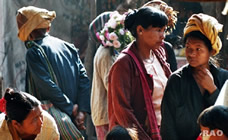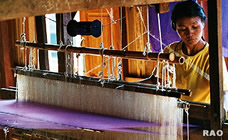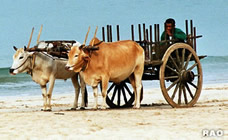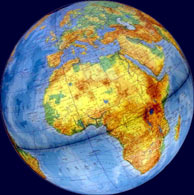 |
| Development |
| Development in Nepal |
|
|
|
|
|
 |
| End Hunger - Walk the World |
|
|
 |
|
 |
| United to end child hunger across the world |
Thousands of children who know what it feels like to be hungry took to the streets yesterday, together with caring citizens, in a worldwide walk to raise awareness about child hunger. From Indonesia to Guatemala, more than 250,000 people in 70 countries participated in End Hunger: Walk the World, an event organised by the World Food Programme together with its largest corporate partners, TNT and Unilever.
 |
|
"Walk the World is the event to raise awareness for all the children who suffer from hunger every day," said Peter Bakker, CEO of TNT. "At TNT we believe that hunger is not acceptable in today's world. I am proud that so many TNT employees, their families and friends on all continents of the world have actively taken part in this Walk to show their solidarity and to raise funds to give these children the daily meal they deserve."
The walk showcased the many faces of hunger across the globe. In Malawi, more than 50,000 people walked in 13 districts, most of them schoolchildren who receive WFP meals. The King of Swaziland joined thousands in the capital, Mbabane. Tanzania had walks in six locations across the country, with over 12,000 participants including the First Lady and Prime Minister.
Indonesia's colourful walk of 12,000 participants was opened by the coordinating Minister for Welfare and WFP National Ambassador Against Hunger, Luna Maya, and followed by a concert featuring popular bands.
Guatemala, a country where approximately half of all children are chronically malnourished, kicked off its Walk on May 14th with the support of WFP Honorary Spokesperson Lauren Bush, with a turn-out of over 20,000 people. Honduras saw the participation of more than 30,000 in Tegucigalpa, and San Pedro Sula.
Under the patronage of HRH Princess Basma, Chairperson of the Jordanian National Alliance Against Hunger, 8,000 participants walked five kilometres across the campus of the University of Jordan on May 12th in support of Walk the World. In Egypt, the event was held under the auspices of the First Lady.
Walks also took place in 25 European countries in 70 locations around landmarks such as Windsor Castle in the UK, Cologne Cathedral in Germany, Plac Pi©©sudskiego in Poland and the Little Mermaid monument in Denmark.
"I am very proud that employees across all regions unite and actively engage to raise awareness of child hunger and malnourishment," said Doug Baillie, Unilever's President west Europe.
| Source: World Food Programme WFP, June 2008 |

|
| Walk the World campaign |
On Sunday 21 May 2008, more than 760,000 people in 118 countries and 420 locations, across 24 time zones, participated in Fight Hunger: Walk the World.
The world community still has to make a huge progress in order to improve the lives of children. Fight Hunger: Walk the World makes a step forward on the path
All around the globe, people came out in force to deliver a message: child hunger has no place in this world and citizens working together can root it out.
WFP, its humanitarian and corporate partners, political leaders, artists and sport champions, as well as war-displaced families and over 100,000 school children in sub-Saharan Africa alone, stepped forward in fight against child hunger.
From Auckland New Zealand, to the pacific ocean island of Samoa, people rose up to declare it is unacceptable that 18,000 children die of hunger daily on a planet that produces more than enough to feed every inhabitant.
Out in all weather
International capitals, rural communities, neighbourhoods and historical landmarks served as the backdrop to walks which varied in size and style.
In northern Uganda alone, on a hot and sunny day, more than 100,000 displaced civilians living in camps participated in the Walk.
 |
|
Swimming oceans, climbing mountains
Participants in Lesotho had a wonderful time during the 11km Walk in Maseru, which was led by the country's Hon. Queen 'MaSenate Mohato Bereng Seeiso.
The President of Liberia Ellen Johnson Sirleaf was at the head of a 30,000-strong crowd through Monrovia that ended in the City Stadium.
In Indonesia, a world champion swimmer set a new world record on behalf of Walk the World by crossing the treacherous Bali straits while other supporters of ending child hunger were planting Walk the World: Fight Hunger flags at Mount Everest and Kilimanjaro summits.
The call to end child hunger was heard in Red Square in Moscow, on The Great Wall of China, in the historic centres of Budapest and Prague, in the old cities of Amman and Cairo, and in hundreds of other locations in all continents around the globe.
Papal support
And in his special Sunday morning address, participants around the world were encouraged when Pope Benedict XVI expressed his support for the Fight Hunger: Walk the World initiative to end child hunger by 2015.
"If we ignore child hunger, it remains a daily reality that ravages millions and goes unseen by most. We are bringing this otherwise invisible problem into the spotlight and moving citizens and governments to action," said Arlene Mitchell, WFP Director of Walk the World.
"There is no excuse for children to be chronically hungry, day in and day out in the 21st century. The world community still has to make a huge progress in order to improve the lives of children. Fight Hunger: Walk the World makes a step forward on the path."
"The event, initiated three years ago by TNT, global provider of express, mail and logistics services, aims to engage citizens worldwide, throughout the next decade to achieve the Millennium Development Goal of halving the proportion of hungry people globally by 2015," said Mitchell.
"Without citizen action, the status quo will remain. But with it, the world can help to end the unnecessary suffering of children."
Reducing hunger
The cash raised through the walk (the final tally is being calculated) will fund two successful global activities aimed at reducing child hunger: projects to help pregnant and lactating women and young children and school feeding projects which provide food for school students in developing countries.
Last year, WFP provided school meals for 21.7 million children in 74 countries.
The Programme plans to reach 50 million schoolchildren by 2008. All too often pupils - particularly girls - are deprived of education because their families cannot afford to send them to school.
Yet educating girls is one of the best ways of permanently escaping the vicious cycle of poverty, illiteracy, poor health and hunger.
| Source: World Food Programme WFP, May 2008 |

|
| more information |
| External link |
| FAO | UNICEF | WFP |
|
|
 |
 |
 |
 |
|
|
